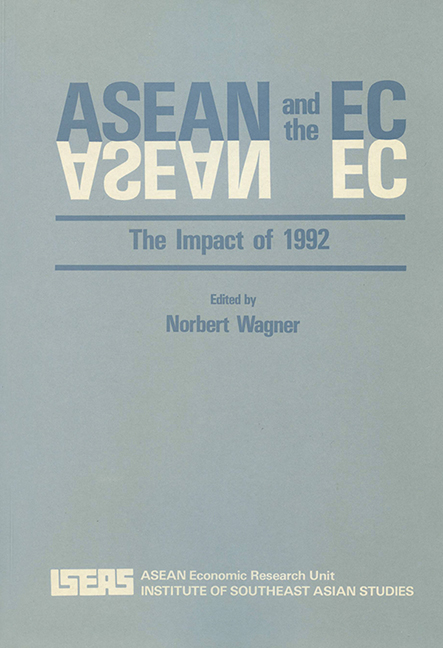Book contents
- Frontmatter
- Contents
- List of Tables
- List of Figures
- Acknowledgements
- PART I INTRODUCTION
- PART II COMPLETING THE EC INTERNAL MARKET
- II Completing the EC Internal Market: An Update and Problems Ahead
- III The EC Internal Market Programme: Implications for External Trade
- IV The EC Internal Market: Implications for Capital Flows
- PART III IMPLICATIONS FOR ASEAN
- Contributors
III - The EC Internal Market Programme: Implications for External Trade
from PART II - COMPLETING THE EC INTERNAL MARKET
Published online by Cambridge University Press: 09 November 2017
- Frontmatter
- Contents
- List of Tables
- List of Figures
- Acknowledgements
- PART I INTRODUCTION
- PART II COMPLETING THE EC INTERNAL MARKET
- II Completing the EC Internal Market: An Update and Problems Ahead
- III The EC Internal Market Programme: Implications for External Trade
- IV The EC Internal Market: Implications for Capital Flows
- PART III IMPLICATIONS FOR ASEAN
- Contributors
Summary
Assuming that the 1992 programme proceeds broadly as scheduled, what are the implications for the external trade of the European Community (EC)? The official documents which launched the programme (Commission of the European Communities 1985; Cecchini 1988; Emerson et al. 1988) were rather unforthcoming on this question. In the recent past, however, efforts have been made to repair this omission (Sapir 1989; Henderson 1989; Langhammer 1990; Davenport 1989; Matthews and McAleese 1990; Pelkmans 1989). A growing literature has appeared on the effects of 1992 on trade in general (including services), on trade with developing countries, and on foreign investment.
This chapter addresses the impact of 1992 on EC external trade and direct foreign investment (DF1). It presents an overview of the situation with an ASEAN perspective in mind. Detailed analyses of the effects on particular aspects of ASEAN trade are presented in other chapters in this volume.
Identifying the external effects of 1992 is, of course, a complex task. One reason is that the 1992 programme happens to coincide with a series of other changes in the trade policy environment: the enlargement of the Community to include Spain and Portugal; reform in the Common Agricultural Policy (CAP); the Uruguay Round negotiations; Lomé IV; renewal of the Multi-Fiber Arrangement (MFA); and the development of new relations with the socialist bloc. Another source of complexity concerns the nature of change in the post-1992 internal market environment — a wide range of non-tariff barriers and regulatory practices are being scrapped, the trade impact of which is notoriously difficult to quantify.
The plan of this chapter is as follows. First, the effects of 1992 on EC trade policy is considered. Next we look into the trade effects of 1992 in a schematic way. Third, the main issues affecting trade in primary and manufactured goods are examined. Fourth, this analysis is extended to include DFI and terms of trade.
- Type
- Chapter
- Information
- ASEAN and the ECThe Impact of 1992, pp. 72 - 87Publisher: ISEAS–Yusof Ishak InstitutePrint publication year: 1991



